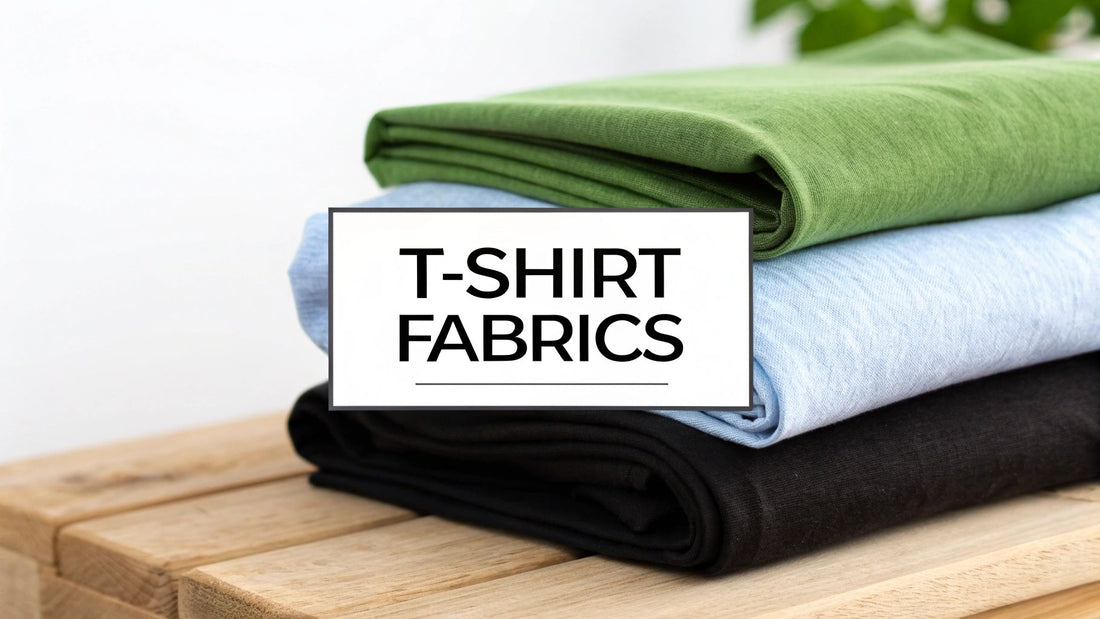
Your Expert Guide to T Shirt Material
Share
Picking the right t shirt material is a lot like choosing the right tires for a car. You wouldn't put racing slicks on a family minivan, right? The same logic applies here. The best fabric for a rugged work shirt is completely different from what you'd want for a soft, vintage-style band tee. The big three you'll always hear about are breathable cotton, tough polyester, and versatile blends that try to give you the best of both worlds.
Why Your T Shirt Material Matters
Let's be honest, the fabric is the soul of the shirt. It’s the very first thing you notice when you touch it, and it dictates almost everything that comes after—comfort, how it holds up over time, and especially how well your design will print and last.
Choosing the wrong material can be a disaster. It can lead to a stiff, boxy shirt that shrinks into a belly top after one wash or a print that cracks and peels away, leaving your awesome design looking like a faded mess. Think of the fabric as the foundation of a house. If you build on a weak foundation, it doesn't matter how great the rest of the house looks; it just won't last.
Key Factors To Consider
Before we get into the nitty-gritty of specific fabrics, let’s talk about what actually makes a material good or bad for a particular job. When you're weighing your options, keep these four things in mind:
- Comfort and Feel: Is it soft and buttery against the skin, or does it feel a bit rough? Is it lightweight and flowy, or does it have more structure and weight?
- Breathability: This is a big one. Does the fabric let air pass through easily to keep you cool, or does it trap heat and moisture? Absolutely critical for gym clothes or anyone living in a hot climate.
- Durability: How tough is it? You need a shirt that can handle being worn and washed over and over without losing its shape, shrinking, or developing those annoying little fuzzballs (pilling).
- Printing Suitability: This is where the magic happens. How well does the fabric take the ink? Some materials soak it up for a vibrant, lasting finish, while others are better suited for specific techniques like DTF or sublimation.
The image below gives you a quick snapshot of where the most common fabrics really shine.
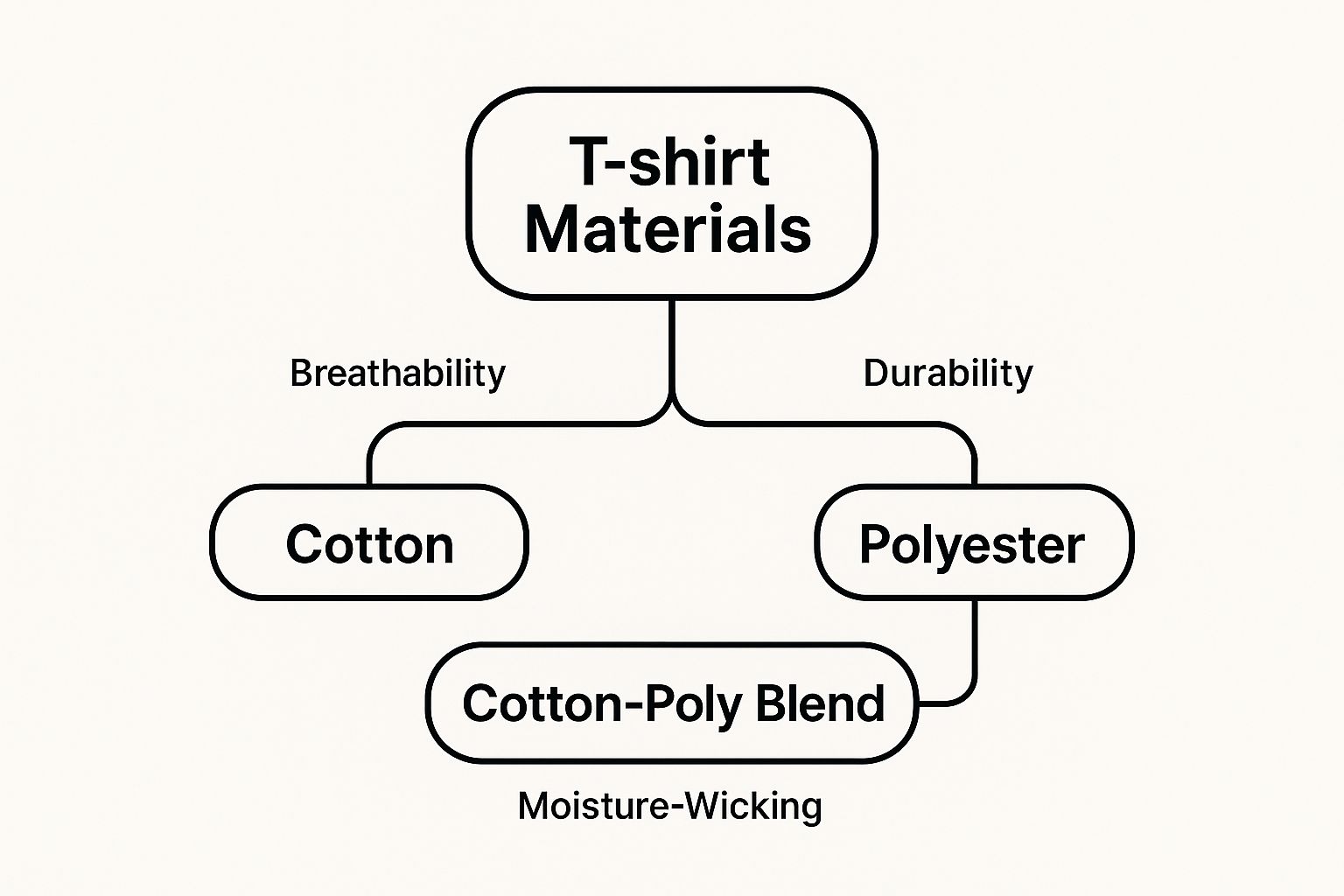
As you can see, each one has its superpower. Cotton is the king of breathability, polyester is the champion of durability, and blends offer that happy medium. Getting a handle on these basic differences is the first real step to picking the perfect tee for your project.
A t-shirt's material is its most defining characteristic. It impacts not only the wearer's experience but also the garment's longevity and the visual quality of any customization.
To make things even easier, here’s a quick-glance table that breaks down the main players. It’s a great starting point before we dive deeper into each one.
Quick T Shirt Material Comparison
This table gives you an at-a-glance summary of common t-shirt materials, their distinct feel, and what they're best used for.
| Material | Feels Like | Best For | Printing Suitability |
|---|---|---|---|
| 100% Cotton | Soft, natural, and breathable | Everyday wear, casual apparel, merchandise | Excellent for DTF & DTG |
| 100% Polyester | Smooth, silky, and lightweight | Athletic wear, performance gear, uniforms | Ideal for sublimation |
| Cotton/Poly Blend | Soft like cotton, but more resilient | Versatile use, from fashion to workwear | Good for DTF & screen printing |
| Tri-Blend | Exceptionally soft, stretchy, and drapey | Premium fashion tees, vintage-style shirts | Great for a faded, retro look |
Think of this as your cheat sheet. Now, let's explore what makes each of these materials tick.
What About Good Ol' Cotton?
When you picture a classic t-shirt, what comes to mind? For almost everyone, it's cotton. There's a good reason it's the reigning king of casual wear—it just feels right. Cotton is soft, it breathes, and it has that familiar, lived-in comfort that makes it the default choice for everything from concert tees to high-end fashion staples.
This natural fiber is the perfect blank canvas. Its absorbent nature lets air flow, keeping you cool when things heat up. That breathability is a huge part of why it’s been a wardrobe mainstay for generations.
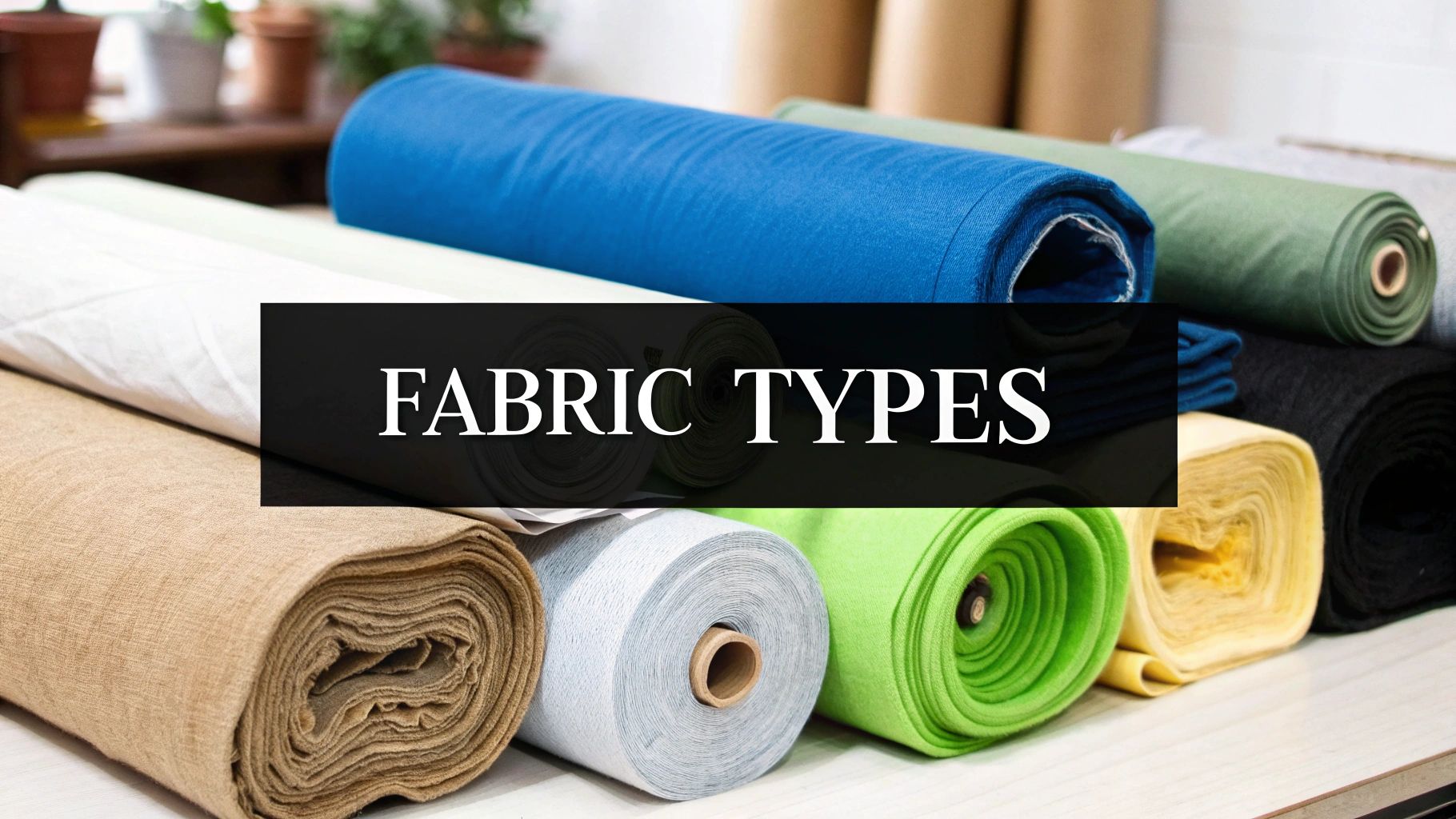
It’s not just a feeling; the numbers back it up. Cotton is a giant in the apparel world, and it’s projected to make up around 41.7% of all digitally printed garments by 2025. This blend of comfort and print-friendly versatility keeps it at the top of the list for both brands and the people who wear them.
But Not All Cotton Is Created Equal
Here’s a little inside baseball: seeing "100% cotton" on a label only tells you part of the story. How that cotton is processed makes a world of difference in how the final shirt feels and performs. Think of it like coffee beans—the same bean can taste completely different depending on how it's roasted.
Let's break down the types you'll run into:
- Standard Cotton: This is your entry-level, workhorse cotton. The fibers are "carded" to get rid of the big impurities. It's affordable and does the job, but can feel a bit rough and won't stand up to wear and tear as well as the others.
- Ringspun Cotton: Now we're talking. This is a big step up in quality. The cotton fibers are twisted and thinned out, which creates a yarn that's much finer, stronger, and way softer. A ringspun tee feels immediately smoother and more premium.
- Combed Cotton: This process takes ringspun cotton to the next level. Just like the name says, the fibers are literally "combed" to pull out any short, scratchy bits left over. What you're left with is an incredibly smooth, consistent fabric that makes for a beautiful printing surface.
- Pima and Supima Cotton: Welcome to the luxury class. These are known for their extra-long staple (E.L.S.) fibers, which create a fabric that's ridiculously soft, incredibly strong, and fights off pilling and fading. Supima is simply a trademark for top-tier Pima cotton grown right here in the USA.
The real secret between a $5 bargain bin tee and a $35 designer one? It often boils down to these details. Ringspinning and combing aren't just fancy terms; they create a fundamentally better shirt that feels amazing, lasts longer, and shows off your print perfectly.
The Pros and Cons of Cotton
Cotton is a fantastic choice for most DTF projects, but let's be realistic—it's not perfect for every situation. Knowing its strengths and weaknesses is the key to getting a great result.
Why You'll Love Cotton:
- Pure Comfort: It's soft, natural, and easy on the skin. A great pick for anyone with sensitivities.
- It Breathes: Those natural fibers let air circulate, keeping you from feeling stuffy.
- A Perfect Canvas for Prints: Cotton drinks up ink, which is exactly what you want for DTF. Designs come out sharp, vibrant, and they last.
Things to Keep in Mind:
- It Holds Moisture: Unlike synthetics, cotton absorbs sweat and gets heavy. It’s not the best choice for a hardcore gym session.
- The Shrink Factor: Unless the tag says "pre-shrunk," a 100% cotton tee is likely to get a bit cozier after its first trip through the washer and dryer.
- It Can Wrinkle: Cotton wrinkles more easily than blends, so it might need a quick iron to look its best.
To see exactly how cotton squares up against its biggest competitor, check out our deep dive into cotton vs. polyester shirts. Understanding the core differences will help you nail the right garment choice every time.
At the end of the day, for amazing-looking prints and that classic, comfortable feel, cotton is still the undisputed champion.
Exploring Performance Polyester Fabrics
If cotton is the comfortable, everyday classic, then polyester is the high-tech athlete of the t-shirt world. This synthetic fabric is engineered from the ground up for one thing: performance. When you need a shirt that can keep up with intense activity, polyester is almost always the best choice.
Think of it like this: you wouldn't wear a casual cotton tee to run a marathon. The fabric just isn't built for that kind of stress. Polyester, on the other hand, has fibers specifically designed to repel water instead of absorbing it, making it the undisputed champion of moisture management.
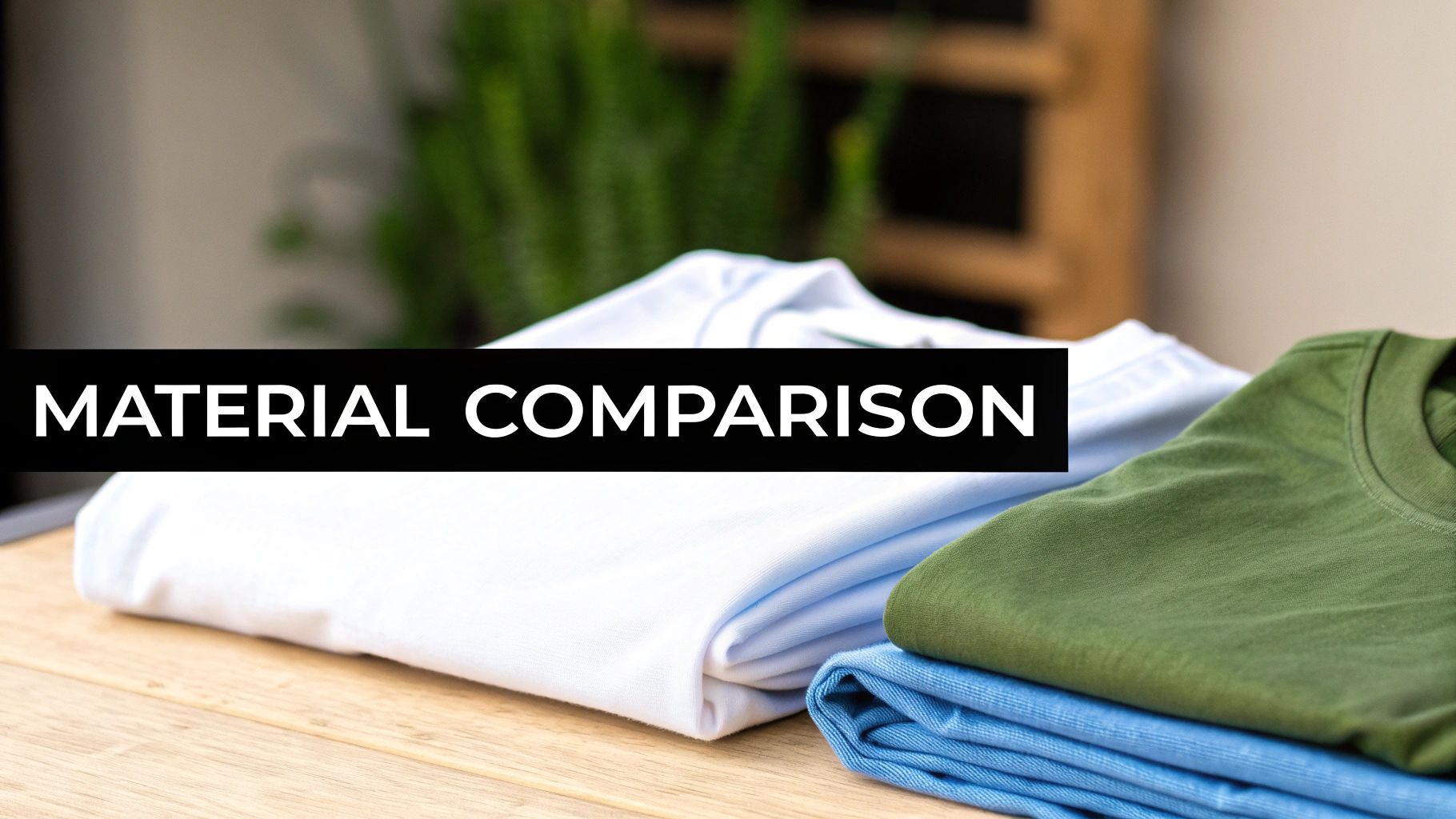
This key feature, known as moisture-wicking, is polyester's secret weapon. Rather than getting soaked with sweat like a cotton sponge, it actively pulls moisture away from your skin. The sweat is drawn to the fabric's outer surface, where it can evaporate quickly, keeping you dry and comfortable no matter how hard you push.
The Science Behind the Performance
At its core, polyester is a type of plastic derived from petroleum. Now, that might not sound very appealing to wear, but modern manufacturing has transformed it into an incredibly effective and versatile textile. The smooth, non-absorbent quality of these man-made fibers is what gives polyester its signature performance characteristics.
This synthetic construction also gives it a serious edge over natural fibers in a few key areas, especially when it comes to holding up over time.
- Exceptional Durability: Polyester fibers are incredibly strong. They resist stretching, shrinking, and wrinkling far better than cotton, so the shirt maintains its shape after countless workouts and wash cycles.
- Color Retention: The material is fantastic at holding dye. This means your designs and colors stay bright and vibrant for the long haul, without fading.
- Abrasion Resistant: It holds up exceptionally well to friction and rubbing without pilling (those annoying little fuzzballs), which is why it's a go-to for team jerseys and tough workwear.
When you're marketing performance apparel, great visuals are everything. High-quality photography is essential when showcasing fitness products to truly demonstrate how the fabric moves and performs.
Polyester and Printing Perfection
Beyond just wearing well, polyester is the absolute best fabric for sublimation printing. This process uses heat to turn ink directly into a gas, which then permanently bonds with the shirt's synthetic fibers.
The result is a print you can't even feel—it literally becomes part of the fabric. It’s unbelievably vibrant, capable of holding incredible detail, and it will never crack, peel, or fade away.
For full-color, edge-to-edge designs that pop with photorealistic quality, nothing beats sublimation on a 100% polyester t shirt material. The synthetic fibers provide the perfect canvas, locking in the dye for a finish that is as durable as the garment itself.
This makes polyester the obvious choice for custom sports jerseys, event merchandise, and any apparel where you need stunning, permanent graphics that truly stand out.
Understanding the Trade-Offs
Of course, no fabric is the right choice for every single situation. As great as polyester is for performance, it does come with a few drawbacks you should be aware of.
The main one is breathability. Because polyester's fibers are designed to repel moisture, they don't let air flow through as freely as the porous fibers of cotton. For some people, this can create a "clammy" or slick feeling during casual, low-intensity wear.
It's also a petroleum-based product, which means it isn't biodegradable. On top of that, it has a tendency to hold onto odors more than natural fibers, sometimes requiring special sports detergents to get it completely fresh again.
Ultimately, choosing polyester is a choice to prioritize durability, moisture-wicking, and print vibrancy above all else. For athletic apparel, team uniforms, or demanding work environments, it’s an unbeatable t-shirt material that delivers reliable performance time and time again.
The Best of Both Worlds with Blended Fabrics
Why pick one when you can have it all? That's the whole idea behind blended fabrics. Instead of being stuck with the limitations of a single material, textile engineers figured out how to weave different fibers together to create something better than the sum of its parts.
Think of it like making the perfect cup of coffee. You take the rich flavor of one bean and blend it with the smooth finish of another. In the t-shirt world, that means combining the natural softness of cotton with the tough, wrinkle-fighting power of polyester. The result is a shirt that solves the common problems of single-fiber fabrics, giving you a balanced material that’s ready for anything.
The Powerhouse CVC Blend
Walk into any print shop, and you'll hear people talking about CVC blends. The name stands for Chief Value Cotton, and it tells you exactly what you’re getting: a fabric where cotton is the star of the show.
Typically, CVC is a 60% cotton and 40% polyester mix. That specific recipe is designed to keep the soft, familiar feel of a cotton tee while injecting some serious real-world performance. The polyester works behind the scenes, bringing some major upgrades to the table.
- Less Shrinkage: That dreaded moment when a new shirt comes out of the dryer a size smaller? Polyester helps prevent that by giving the fabric more stability.
- Tougher Build: Polyester fibers are stronger than cotton, which means the blend can handle more wear, tear, and repeated washing. It's a true workhorse.
- Wrinkle-Resistant: The synthetic fibers help the shirt snap back into shape, so you can spend less time ironing and more time wearing it.
- Vibrant, Lasting Color: Polyester locks in dye better than cotton, so colors stay sharp and resist fading over time.
This blend really hits the sweet spot between comfort and toughness, making it a fantastic choice for everything from company merch to durable staff uniforms.
Enter the Ultra-Soft Tri-Blend
If CVC is the reliable daily driver, the tri-blend is the luxury sports car. This is a premium material that takes blending to a whole new level by mixing three different fibers—usually cotton, polyester, and rayon.
Each one has a specific job to do:
- Cotton lays the foundation with its signature softness and breathability.
- Polyester adds the muscle, giving the shirt durability and shape retention.
- Rayon is the magic ingredient. It’s a plant-based fiber that provides a silky smooth feel and a beautiful, elegant drape that makes the shirt hang just right.
What you get is a fabric that’s incredibly soft, lightweight, and drapes perfectly. Tri-blends are famous for their unique "heathered" look, which gives them a cool, vintage vibe straight off the shelf.
Tri-blend fabrics are the pinnacle of comfort in the t-shirt world. The unique combination of cotton, polyester, and rayon creates a material that feels like your favorite, perfectly worn-in tee from the very first wear.
That slightly textured look is also an amazing canvas for DTF prints, especially for retro designs. The ink settles into the fabric for a softer, more integrated appearance, avoiding that heavy, plastic feel you can get on other materials.
Common T-Shirt Blends Breakdown
With so many options out there, it can be tough to keep them all straight. Here’s a quick-glance table to help you compare some of the most popular blended fabrics and figure out where each one really shines.
| Blend Type | Typical Composition | Key Characteristics | Best Use Case |
|---|---|---|---|
| 50/50 Cotton/Poly | 50% Cotton, 50% Polyester | A true jack-of-all-trades. Soft yet durable, and resists shrinking. | All-purpose tees, event shirts, casual wear. |
| CVC Blend | 60% Cotton, 40% Polyester | Cotton-dominant feel with added strength. More breathable than 50/50. | Premium brand merchandise, comfortable work uniforms. |
| Tri-Blend | 50% Poly, 25% Cotton, 25% Rayon | Supremely soft, lightweight, with a vintage look and feel. | High-end fashion t-shirts, retail apparel, fitness tops. |
| Cotton/Spandex | 95% Cotton, 5% Spandex | Stretchy and form-fitting. Keeps cotton’s softness but adds flex. | Athletic wear, fitted tees, performance apparel. |
Ultimately, picking the right blend comes down to what you need that shirt to do. Whether it’s the rugged dependability of CVC or the buttery softness of a tri-blend, these hybrid fabrics offer tailored solutions that pure cotton or polyester just can't match on their own.
How Your Fabric Choice Makes or Breaks Your Printed Design
Picking the right t-shirt material is about so much more than how it feels. The fabric is quite literally the canvas for your art, and its texture, fiber type, and even its color will dictate how your final print looks, feels, and holds up over time. Nailing this decision is often the difference between a t-shirt that looks truly professional and one that’s just a disappointing flop.
Think about it like this: you'll always get a cleaner, sharper image painting on a smooth, primed wall versus a rough, stucco surface. The exact same idea applies to t-shirts. The fabric's weave and composition determine how well the ink adheres, how vibrant the colors appear, and how much detail you can actually transfer from your design to the garment.
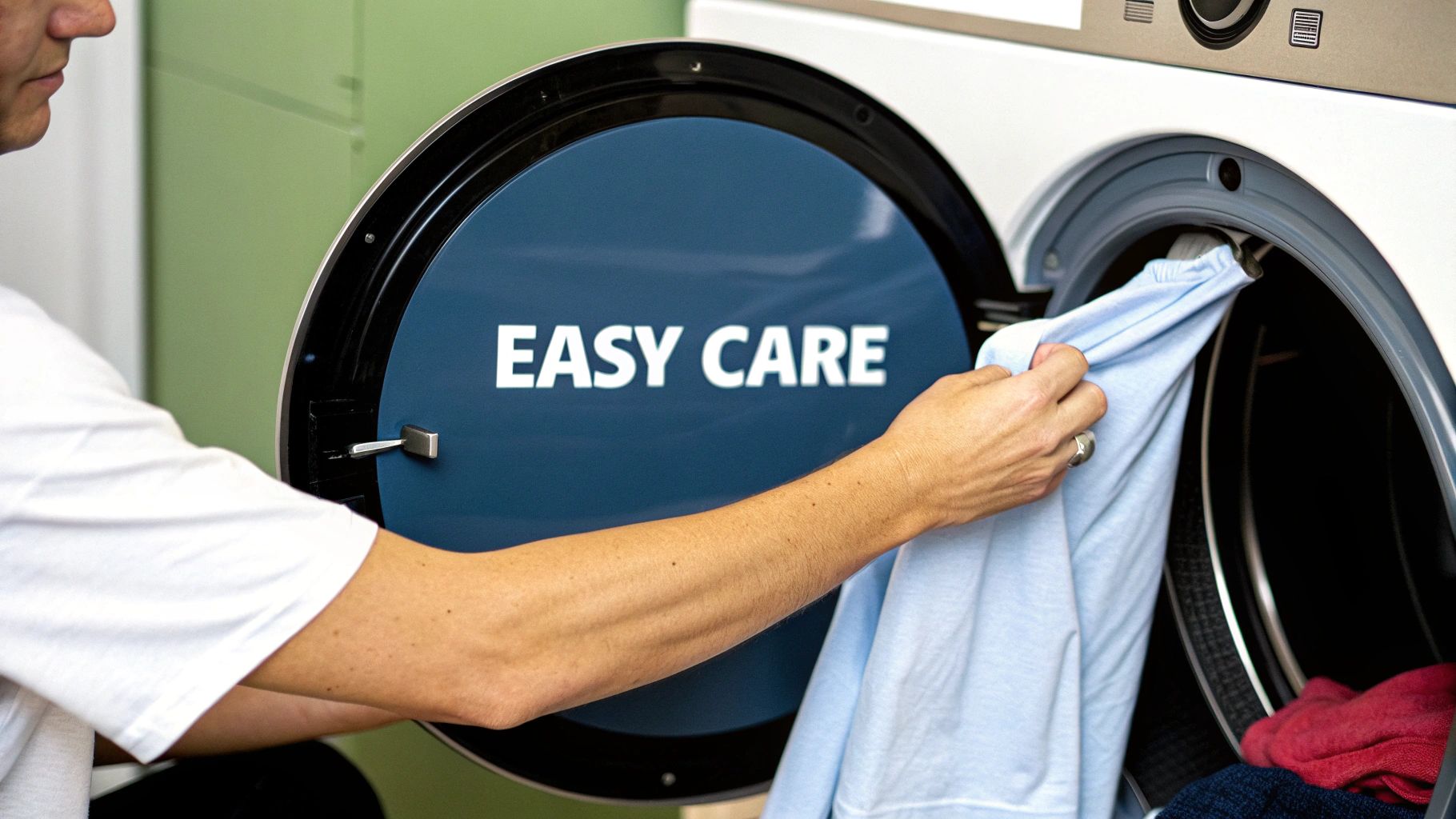
This intimate relationship between fabric and print quality is a huge reason why the global T-shirt market, valued at around $169.1 billion back in 2021, just keeps growing. People want quality they can see and feel, and understanding the materials is how you deliver. As the market expands, so does the need for creators to master their craft from the ground up—starting with the very fibers of the shirt.
Matching Printing Methods to Fabrics
Different printing techniques are built to work best with certain types of fabric. Trying to force a mismatch is like trying to fit the wrong key in a lock; you might get it to turn, but it's not going to work properly. When you're creating custom apparel, especially with tools like AI T-shirt design generators that let you dream up complex visuals, knowing how fabrics react is absolutely essential.
Here’s a quick look at the classic pairings:
- DTF and DTG on Cotton: Both Direct-to-Film and Direct-to-Garment printing are stars on natural fibers like cotton. Cotton is porous and absorbent, so it just drinks up the water-based inks, leading to beautifully rich colors and crisp, sharp details.
- Sublimation on Polyester: This method is polyester's soulmate. The heat-activated dye turns into a gas and permanently bonds with the synthetic fibers, creating a print you literally can't feel. The result is a stunning, photo-quality design that will never crack, peel, or fade.
- Screen Printing on Blends: As the versatile workhorse of the industry, screen printing does a great job on cotton/poly blends. The thick ink sits right on top of the fabric, creating a bold, slightly raised design that’s incredibly durable on these hybrid materials.
Your fabric choice isn't just a matter of preference. It's a technical decision that opens up certain printing possibilities while completely closing the door on others. That amazing, vibrant design you planned for sublimation will look dull and washed out if you accidentally print it on a 100% cotton tee.
Sidestepping Common Printing Problems
By selecting the right t shirt material from the very beginning, you can dodge some of the most common—and frustrating—printing headaches. Every fabric has its own quirks that can either help your design shine or cause it to fail.
For a head-to-head comparison of two major print methods, you should definitely check out our guide on DTF vs. DTG printing.
Here are two classic problems tied directly to fabric choice:
- Fibrillation on Cotton: Ever seen a print look fuzzy or faded after just one wash? That's fibrillation. It happens when loose cotton fibers poke up through the ink layer. You can minimize this by choosing a higher-quality, smoother fabric like ringspun or combed cotton, which provides a much more stable surface for the ink.
- Dye Migration on Polyester: This is a big one for colored poly. The heat used to cure the print can actually cause the dye from the shirt itself to "migrate" or bleed into the ink, staining your design. A perfect example is when white ink turns pink on a red polyester shirt. This is why we use special inks with dye-blocking properties to prevent it.
Understanding these little details ahead of time allows you to anticipate challenges and pick a material that will truly do your design justice.
Common Questions About T-Shirt Materials
Diving into the world of t-shirt fabrics can feel a little overwhelming at first. But once you get a handle on a few key concepts, you'll be able to pick the right shirt for the job with confidence, every single time.
Let's start with the question I hear most often: what's the softest material out there? If you're looking for pure, natural softness, you can't beat premium cottons like Supima or Pima. They're the gold standard. That said, a lot of people (myself included) swear by tri-blends—those clever mixes of cotton, polyester, and rayon—for a ridiculously soft, "broken-in" feel right off the rack.
Performance and Durability Questions
When the conversation shifts from everyday comfort to activewear, performance becomes the top priority. For a gym shirt or anything you'll be sweating in, 100% polyester is the undisputed champ. It’s engineered to pull moisture away from your skin, keeping you dry and comfortable no matter how hard you push. Plus, it's incredibly tough, holding its shape and resisting shrinkage wash after wash.
Speaking of shrinkage, how do you stop your favorite cotton tees from getting too small? The secret is simple: wash them in cold water and tumble dry on low. High heat is the enemy of cotton. If you want to be extra careful, hanging them to air dry is your safest bet. Grabbing a "pre-shrunk" cotton shirt from the get-go also gives you a nice head start.
You'll often see acronyms on clothing tags, and they're not just jargon. Knowing what they mean, like CVC, gives you a quick snapshot of how a shirt will feel and perform.
Understanding Fabric Blends
So, what exactly does CVC mean when you see it on a tag? It's short for Chief Value Cotton. All this means is that the shirt is a blend, but cotton makes up the majority of the fabric—it's the "chief" ingredient.
Typically, you're looking at a 60% cotton and 40% polyester mix. This blend is wildly popular because it really does give you the best of both worlds:
- You get the soft, breathable feel you love from cotton.
- The polyester adds durability, wrinkle-resistance, and helps fight shrinkage.
This smart combination makes CVC a go-to for just about anything, from your favorite weekend t-shirt to a work uniform that needs to last. It’s that perfect middle ground between pure comfort and practical performance.
Of course, the material you choose also affects how your design will print. If you're using transfers, the fabric can make or break the final look. We put together a guide that breaks down how transfer paper works on different materials to help you nail it every time. Starting with the right fabric is half the battle.
Ready to bring your designs to life on the perfect fabric? Cobra DTF provides premium, USA-made DTF transfers that deliver vibrant, lasting results on cotton, polyester, and blends. Get professional quality with fast, reliable shipping by visiting https://cobradtf.com today.
